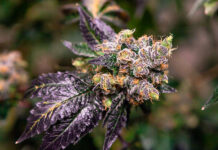
Compared to other industries, cannabis progresses in dog years. Trends flicker and fade fast, so predictions are especially difficult.
Nancy Whiteman knows how the culture evolves. She’s been profiled on Forbes.com, CNBC, and Inc. magazine, the last of which called her “the queen of the $1 billion legal weed industry” for her role as CEO of Wana Brands, Colorado‘s biggest maker of cannabis-infused edibles. Whiteman has garnered respected within the industry, earning the title of the Most Important Woman in cannabis in 2017 by Cannabis Business Executive.
Weedmaps News sat in on her South by Southwest (SXSW) talk about non-obvious trends in the industry. SXSW presented on March 14, 2019, its inaugural canna-business tract, which also featured post-traumatic stress disorder researcher Sue Sisley and four cannabis industry veterans in an hourlong discussion about dispensaries of the future.
Here are the five predictions Whiteman offered:
1. The Bottom Will Fall Out of CBD
For all the benefits of cannabidiol (CBD), Whiteman believes it’s the sector of the cannabis field that’s most at peril. With its great boom, thousands of companies have emerged, but once the Food and Drug Administration (FDA) comes to town, the new regulations may prove to be more than upstart companies can handle. “In my opinion, the vast majority who are rushing into the CBD market will be out of business pretty soon when they need to figure out how to comply with all these regulations,” Whiteman said.
The cannabidiol (CBD) products industry is expected to be a multi-billion-dollar industry in the next few years, and upstarts are rushing to fill the space. (Weedmaps News File Photo)
She predicts regulations to keep companies hawking less rigorously designed products. Good Manufacturing Compliant facility requirements, which include “record-keeping, personnel qualifications, sanitation, cleanliness, equipment verification, process validation, and complaint handling” require a level of diligence that will weed out many. Dosage guidelines, third-party lab-testing, and labeling laws are more hurdles. There’s also the fear of Big Pharma streamlining CBD extraction so much that purer forms of processing become mandatory, a major threat to homegrown operations.
2. Medical and Recreational Distinctions Will Break Down
In adult-usel states such as California, dispensaries can be licensed to distribute cannabis for recreation, medicinal purposes, or both. The slow rollout of licensing forced the divide, but other than more medically informed budtenders, there isn’t really much distinction between the two classes of dispensary.
“The underlying plant material is the same. There’s no distinction between a medical and recreational product,” Whitehead said.
This may not seem like a revelatory observation, but the statistics driving the dichotomy would surprise most. A survey by cannabis research firm BDS Analytics found that the main drivers of cannabis consumption, “getting high or stoned” didn’t even make the Top 5. Pain relief, relaxation, anxiety management, sleep, quality of life, having fun, and treating medical conditions all ranked above intoxication.
3. Death to Sativa and Indica Labelling
The first thing any consumer of legal cannabis learns is the distinction between sativa and indica. And the next thing they learn is that cannabis strains aren’t so simple.
“Indica and sativa are phenomes. They describe what the plant looks like and how they grow. There’s no universal agreement on which strains fall into which class,” Whitehead said.
Marijuana’s effects have been associated with the species names sativa and indica, but the more is known about plant genetics and cultivation methods, these descriptors are going to be obsolete, Wana Brands CEO Nancy Whiteman forecasted. (Weedmaps News File Photo)
Labeling isn’t uniform. What one dispensary considers a hybrid could be called a sativa or an indica by another. Strains also differ among growers and between harvests. Once testing becomes more rigorous, the catchall categories of sativa and indica will break down, with strains identified by terpenes and cannabinoids. And that shift is already happening in terms of strain names being ditched for flower that is named for the specific effects they’re intended to have, such as blissfulness, relaxation, or creativity.
4. The User Experience Will Be Fine-Tuned
Would you like your edible to kick in within five minutes of eating? And how long would you like it to last — maybe an hour? Testing is underway that will allow companies to design onset and duration such that the experience of partaking in cannabis becomes more and more consistent. Whiteman claimed Wana Brands will soon bring to market an edible with an onset of only five minutes.
In addition to testing, tracking user data will be equally important. Cannabis products affect people uniquely, and until now there hasn’t been a consistent way to analyze and learn from these experiences.
“The emergence of user experience platforms will allow people to track their experiences after they use the product,” Whitehead said. “Either with a QR code or some other kind of AR system that will tie back to the actual batch and lab testing to look at the chemical components of what they’ve taken.”
5. Extraction Will Evolve and Grow
Researchers at Sunrise Genetics in Colorado have successfully mapped the genome of the cannabis plant. That increases knowledge of the DNA of the plant, which has ripple effects across the industry. Extraction will become an even bigger business as supply-side companies understand how to isolate and combine terpenes and cannabinoids for specific effects, which will make it easier for companies making products such as edibles to buy processed cannabis as an ingredient rather than doing their own growing and extraction.
Another key consequence is that strains will become more consistent. Currently, strains can vary depending on the grow house, but knowing the DNA makeup will protect against accidental variations. This helps increase consumer confidence and result in a better overall experience. “Blue Dream in one place is not Blue Dream in another place, but this will allow everyone to agree as to what it looks like from a genetics point of view,” Whitehead said.















